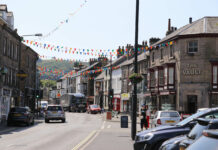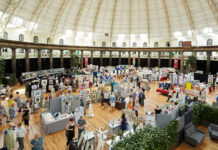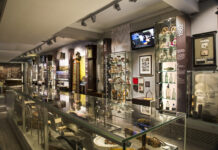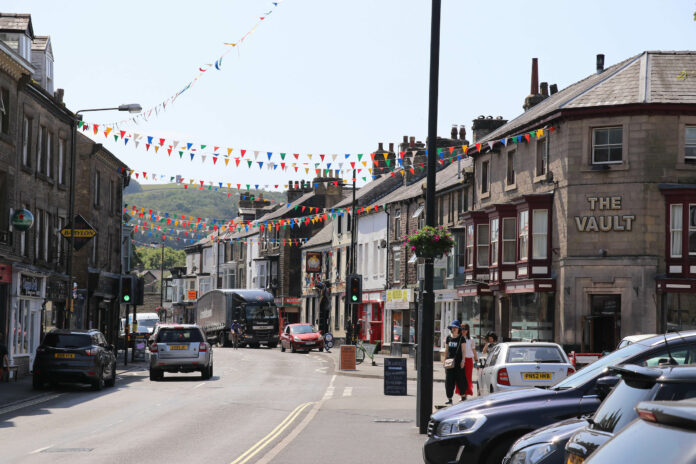If you asked someone familiar with Buxton what makes the place so unique they might answer “the water” or “the weather” or perhaps “the architecture”. All of these answers ring true but if you scratch beneath the surface, you will find features that even most of the locals don’t know about. Join Explore Buxton on an alternative tour of quirky Buxton…
Weird Buxton, Secret Buxton, Paranormal Buxton … welcome to our eccentric town
1. Devonshire Dome: Things That Go Bump in the Dome
Arguably the most spectacular building in town, the largest freestanding dome in Europe can be seen from almost any high point in Buxton. The interior is even more breath-taking. Originally built as somewhat grandiose stables by the Duke of Devonshire (confusingly based in Derbyshire) in 1779, it gradually became a hospital and after a period of vacancy, part of the University of Derby. Given its history and demeanour, it seems almost inevitable that staff who have worked there have troubling experiences to recount and The Dome has frequently been listed as one of the most haunted or spookiest places in Buxton. You don’t have to join a ghost hunt to get a gander, they have a nice bistro.
2. Pavilion Gardens: Centre of the World for Lawn Tennis (almost)
In the late 1800s, Buxton was a popular health spa resort for the middle classes. As well as bathing in the water, drinking the water and having it pumped into various orifices, people were encouraged to participate in a variety of sporting endeavours including a new game called Spairistrike. With the slightly-catchier name of tennis, the vigorous pastime exploded in Buxton and by 1880, a tournament was established in the Pavilion Gardens where there is still a flat green space today. Around the same time, another tournament began in somewhere called Wimbledon. The Buxton version ceased in 1951.
3. Lismore: The Oldest Buxtonians
Buxton is often associated with the Romans but those sandalled feet were by no means the first to wander into town. Archaeological digs have unearthed signs of humans who were here a long time before them and they were found in an unlikely and unassuming part of town. If you take the gentle meander through the Pavilion Gardens to the other side, you will find yourself on Burlington Road and the option of continuing your stroll along the smaller and quieter promenade of The Serpentine. Just beyond the leafy boundaries of “The Serps” a modern housing estate offers a view of a field which has revealed flint fragments 7,000 years old and pottery 4,000 to 5,000 years old. One of the pots found is not just the oldest in Buxton but in the whole country and resides in the town museum (currently closed to the public and waiting for the local powers-that-be to find it a new home).
4. The Old Hall: Prison of Mary Queen of Scots
The Old Hall stands proud as England’s oldest hotel with part of the building dating to 1573. Mary Queen of Scots stayed here whilst in the custody of Queen Elizabeth I. Nowhere in Buxton really makes a big deal of this fact so it’s worth going in to a bit more detail for fans of horrible history: Back in the sixteenth century, Buxton was a fledgling health resort exclusive to the wealthy and elite. Mary Stuart suffered from a multitude of health problems and frequented Buxton to benefit from “the waters” but her claim to the English throne had become a concern for the existing monarchy and in 1569, her custody was ordered.
Mary was placed in the charge of the Earl of Shrewsbury who was advised to keep her in the “baynes at Buckstones.” She was actually moved around a lot but ended up at The Old Hall several times, mainly due to her request for continuing remedy. There may have also been some local support for her cause. Upon one visit, she scratched a couplet called Farewell to Buxton with a diamond ring on one of the bedroom window panes (long since removed):
Buxton, whose fame thy milk-warm waters tell
Whom I, perhaps, no more shall see, farewell
After years of deliberation, Mary Queen of Scots was finally beheaded for treason; a slightly messy execution by all accounts (it took a few swings of the axe to finish the job). Some say Mary still comes to visit The Old Hall, her headless ghost wandering the corridors and rooms of the hotel, in search of her beloved Buxton.
5. Worshipping Water: St. Anne’s Well
The elaborate water pump situated next to the Pump Room provides fresh spa water to be sampled or collected all year round. The well is decorated once a year in July as part of the well dressing festival which also takes place in other towns and villages nearby. The tradition began in Buxton in 1840. Although the dressings have roots in religion, the Buxton festival originates as a “pump festival” to pay tribute to the Duke of Devonshire for providing water to the people. St. Ann’s Well was first decorated in 1841 using the same techniques used today, covering the well in a mosaic made up of flower petals and other materials set into a clay base.
As with other well dressing festivities, a Well Dressing Queen is chosen. The Celtic people who lived here before the Romans may have maintained a similar rite, their druids giving thanks to their gods for the lovely warm water. Written accounts by Romans invading Britain claimed that the druids sacrificed animals and even humans in their pagan ceremonies so the original purpose of choosing a “Well Dressing Queen” may have been far more sinister.
6. The Actor who Ate Himself to Death: St. Anne’s Church
Nestled in a corner, just off the High Street, at the top of Bath Road, this handsome little church is believed to be one of Buxton’s oldest surviving buildings with a date of 1625 carved on its porch. The charming interior, with its thick wooden beams, is well worth a peek and you can ruminate on the fact that when this 400 year old church was under construction, King Charles I was being crowned and the English Civil War would soon be brewing. This is not St. Anne’s only claim to fame; the churchyard is also the final resting place of John Kane, an eighteenth-century actor who was as notorious for his big appetite as well as his dramatic performances. Whilst starring in a production at Buxton Opera House, Kane accidentally consumed hemlock instead of horseradish, leading to respiratory failure. It isn’t clear why Kane was buried in Buxton, instead of his hometown; we can only assume this was a matter of convenience in 1799.
Also worthy of mention is adjacent public house The Swan, whose Tartan Room is a marvel in itself and next to that is Scriveners second-hand bookshop, featuring in The Guardian’s top ten second-hand bookshops in the UK.
7. Buxton’s First Museum: Poole’s Cavern
Poole’s Cavern is Buxton’s top tourist attraction and has been for 400 years. In 1853, most of Buxton was owned by the 6th Duke of Devonshire, including the cave and the Duke was concerned that unofficial tour guides were fleecing tourists for money and inviting them to throw rocks at cave formations that had taken millions of years to form. He invited a local man called Frank Redfern to become its first official custodian and the attraction was rebooted as an official show cave.
Redfern was somewhat of a pioneering showman, installing gas lights and walkways. He also excavated layers of the cave floor , discovering animal and human remains and Roman coins and jewellery. Redfern exhibited his finds in an adjoining museum, alongside artefacts from around the world that included shark jaws, a two-headed calf, an Egyptian mummy’s hand and a shoe buckle belonging to Captain Cook. If the museum and cavern were not enough, there was also a miniature zoo containing monkeys and baboons with a shop selling peanuts so visitors could feed them. There was even a brass band that played twice a week and an archery range. Quite why Redfern felt the need to embellish Poole’s Cavern with all these sensational yet irrelevant features is unclear. It is possible that he was just trying to create an unforgettable experience for his Victorian clients, an outcome he surely must have achieved. The museum eventually fell into disrepair and most of its exhibits lost but you can still see traces of it today, most notably the original ticket booth at the front.
8. Solomon’s Temple: Buxton’s own Indiana Jones
If you read about Buxton’s history, it probably won’t be long before the name Micah Salt crops up which sounds a bit like some obscure mineral but he was actually a resident who was famous for pioneering archaeology. He excavated several sites including the bronze age burial mound that Solomon’s Temple sits on. The “temple” itself was rebuilt in 1896 to replace a version that had been constructed by local landowner Solomon Mycock and arguably offers the best viewpoint of the town and the Peak District beyond.
9. Harpur Hill: Buxton’s Area 51
Whilst gazing at the landscape from Solomon’s Temple, it is worth considering the old man-made cliffs of Hoffman Quarry and industrial complex that crown Harpur Hill directly to the south. Most of this belongs to Health and Safety Executive. Sprawled across 500 acres of moorland and the antiquated quarry, not to mention an underground complex that could be rented to a James Bond villain, the facility employs hundreds of scientists and technicians who conduct experiments to research and improve the wellbeing of the nations’s workforce. You know those risk assessments at work? They probably began life here.
The site is protected by strict military-style security so don’t go for a closer look. Given HSE don’t want members of the public wandering into the middle of a controlled explosion, the secrecy and security is justified. However, conspiracy nuts insist the true nature of the lab is more sinister than meets the eye. There have been glimpses of strange structures amongst the hills, with no identifiable purpose, protected by bizarre automated perimeter controls. It doesn’t help that the staff are sworn to secrecy about the precise nature of what they do for a living. It is no wonder that the place has become known as Buxton’s Area 51, a comparison to an US Air Force Base in Nevada where they allegedly reverse-engineer alien spacecraft (Buxton’s hills have their fair share of mysterious lights in the sky).
10. A Path Less Trodden: The Old Road to Macclesfield
It is perfectly possible to drive from Buxton to the town of Macclesfield some eleven miles away. However, there is a much older road that runs roughly parallel to this one as far as the Cat and Fiddle (once the second highest pub in the UK but at this time of writing, a distillery for Macclesfield Gin) and this is referred to as the Old Macc Road. You can occasionally glimpse one road from the other as they twist stubbornly in the same direction without ever meeting, like two distrustful travellers. You would struggle to get a vehicle along the older route, thought to date back to medieval times. The path is slowly being reclaimed by nature and is now difficult to negotiate even by foot. The gradual rise is steep and strewn with rocks and boulders. As you puff and pant your way out of Buxton into seemingly nowhere, you may want to spare a thought for the men who used to cart patrons up to the pub in a contraption called the bathchair, a sort of encased Victorian wheelchair.
There were once a few abodes along this road and a fledgling coal mining industry too. You can spot the odd scrap of evidence along the way, most notably the large coke oven near the start of the trail. If you depart from the Old Road across Axe Edge Moor (there’s a signpost), you will discover a chain of old mine shafts which have been thankfully fenced off, probably to help out the resident sheep more than anyone else. Those willing to brave the less trodden path to Macclesfield are rewarded with a majestic view of the Goyt Valley …
11. Domain of the Downright Strange: The Goyt Valley
For hundreds of years, The Goyt Valley had a thriving community of its own including a gunpowder mill, a paint factory and a busy railway line. All industry ended in the 20th century when bigwigs in Stockport decided they needed more water and most traces of civilisation are now lost beneath the twin reservoirs of Errwood and Fernilee. Like ghosts returning to haunt us, some of the old structures reappear when the water is low in the summer.
You can still visit the ruins of the Victorian mansion called Errwood Hall. Quite why Stockport Corporation felt the need to knock down an impressive house that was nowhere near the water is a matter of dispute. The most likely explanation is that they couldn’t be bothered with its maintenance. Now little more than a pile of stones in a sea of rhododendron, the Hall still gets thousands of visitors every year, perhaps drawn to the mystique of the mansion in the woods. The adjacent family graveyard adds extra fuel to the creepy atmosphere.
If the remains of a lost community amidst a bleak valley are not enough to get your spine tingling then you should consider the myriad sightings of ghosts, big cats, UFOS and other abnormalities that defy classification.
12. The Hobgoblin’s Lair: Deep Dale
Challenging The Goyt Valley’s crown for spookiest place in Buxton is Deep Dale, although admittedly we are pushing the town’s boundaries somewhat by a few miles. This lonely valley is a natural beauty spot but there is a somewhat eerie atmos, compounded by the presence of a cave called Hob’s House, sometimes known as Hob Hurst or Thirst House. Two Neolithic human skeletons were recovered from its depths by Victorian archaeologist Micah Salt (see no. 8 above), following their discovery by two local boys. So, yeah, a cave named after a hobgoblin’s house where bodies were once found; how creepy can you get?
We don’t recommend going into the depths of the cave nor visiting Deep Dale nor anywhere remote in the Peak District by yourself, or without telling anyone, and always wear sensible gear. Quirky quests can be super fun but please stay safe!
Did You Enjoy This?
You might like our regular newsletter. We put all the best events, cultural highlights and offers from Buxton and the Peak District in your inbox every month.
This information will only be used to send you this newsletter. It is stored in Mailchimp.










